The council is to review secondary school admissions, with the aim of reducing the number of spare places, redrawing catchment areas in the process and aiming to ensure poorer pupils do better.
Falling pupil numbers have already led to the council voting to close two primary schools – and a senior councillor said that he was keen that none of the secondaries should shut.
But, with funding based mainly on pupil numbers, Councillor Jacob Taylor said that Brighton and Hove City Council had to work with schools to reduce spare places.
A key aim of the review is to cut 345 year 7 classroom places – from 2,560 to 2,215 – by September 2030.
The number of students starting secondary school is expected to have fallen from 2,278 next September to 2,023 by September 2030.
But four of the ten secondary schools in Brighton and Hove are either academies or church schools which set their own admission numbers. They currently offer 925 year 7 places – or 36 per cent of the total.
The council said: “We cannot change admissions arrangements for church schools, academies and free schools as these are the responsibility of their governing boards. However, we are aiming to work closely with these schools throughout the process.”
Under the initial proposals, 90 places a year would be cut from the published admission number (PAN) at both Blatchington Mill and Longhill, 60 places at both Dorothy Stringer and Varndean and 45 places at Patcham High. No change is proposed for the academies or church schools.
Councillor Taylor said that another key aim was to address the “attainment gap” between “disadvantaged” pupils and those who were better off.
Disadvantaged pupils tended to do less well in exams than those were not disadvantaged but the gap in attainment was wider in Brighton and Hove than the national average.
The review would be a way to look at how disadvantaged pupils could have better chances by ensuring a more even balance of children eligible for free school meals.
At four of the ten schools, the proportion of 11 to 16-year-old pupils eligible for free school meals is above 30 per cent.
- BACA – 46.4 per cent
- Longhill High – 40.2 per cent
- Hove Park – 32.7 per cent
- PACA – 30.7 per cent
- Patcham High – 22.2 per cent
- Varndean – 21.0 per cent
- Dorothy Stringer – 20.9 per cent
- Blatchington Mill – 18.3 per cent
- Cardinal Newman – 17.1 per cent
- King’s – 16.6 per cent
The council has published a map of the existing catchment areas and three options – A, B and C – with option B making the biggest change to the distribution of disadvantaged pupils.
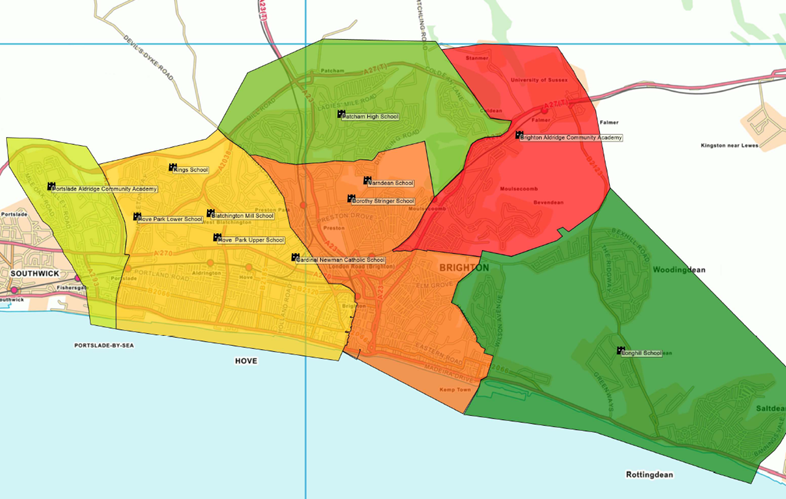
Option A – amending existing model
- This option tries to make minimal changes to the catchment area boundaries but some changes have been made to ensure that all schools in the city have enough pupils in their catchment area to remain viable.
- Hove and Portslade catchment areas remain virtually unchanged.
- Where boundaries have been moved, the percentage of children eligible for free school meals was taken into account to try to keep these numbers equitable across the different catchment areas.
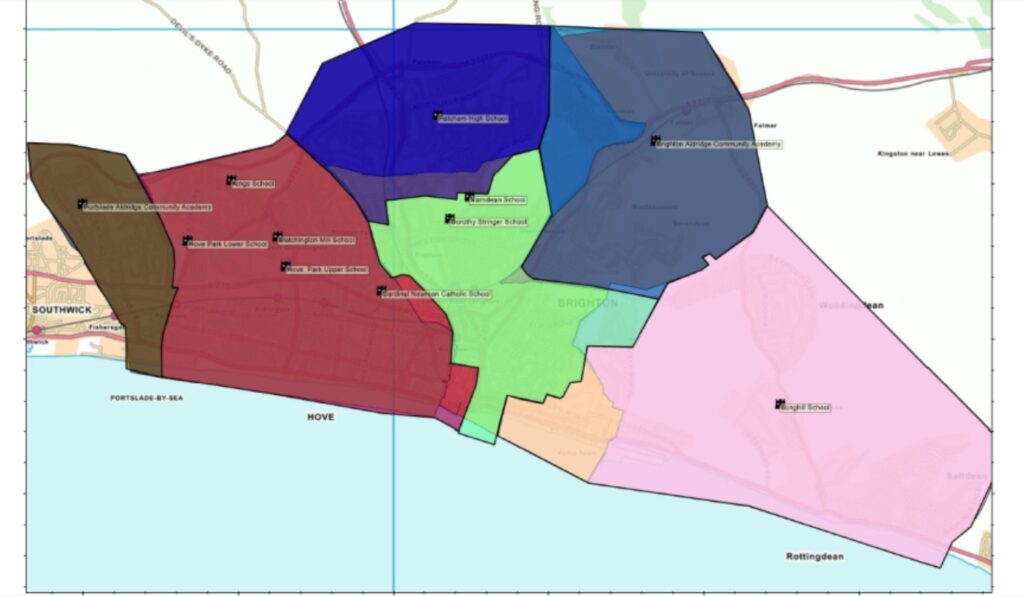
Option B – moving to four catchment areas
- Hove and Portslade catchment areas remain virtually unchanged with the rest of the city divided into two catchment areas with a north-south divide.
- Boundaries have been drawn for this option to keep distinct communities in the same catchment area where possible and to ensure that the schools are situated within their own catchment area.
- Boundaries have been drawn to try to keep the percentages of free school meals children equitable across the different catchment areas.
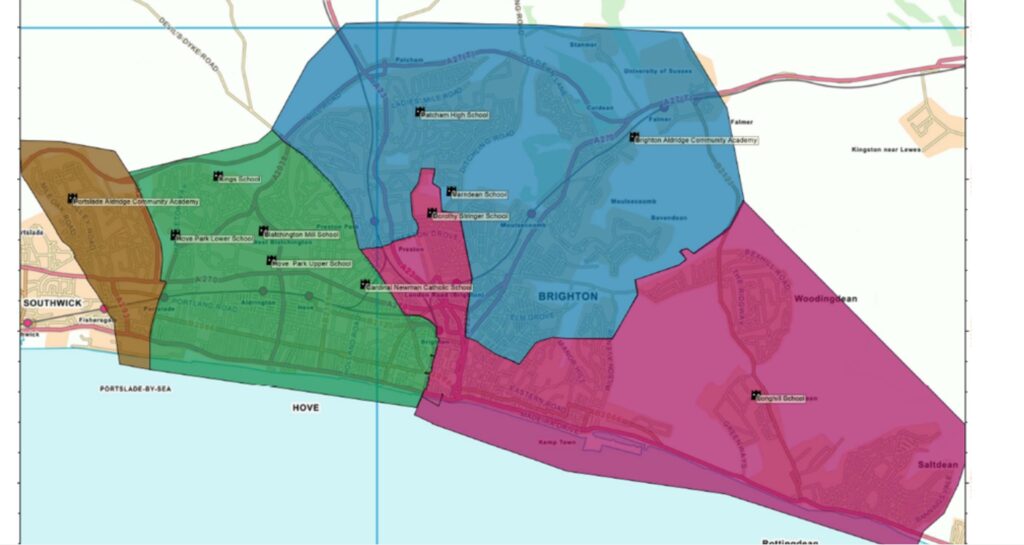
Option C – moving to single catchment areas
- Giving each school a distinct catchment area.
- Boundaries are drawn to ensure the schools are within their designated catchment area.
- Each school’s area is required to have sufficient pupils for the schools to remain viable.
- Boundaries have been drawn to try to keep their percentages of free school meals children equitable across the different catchment areas.
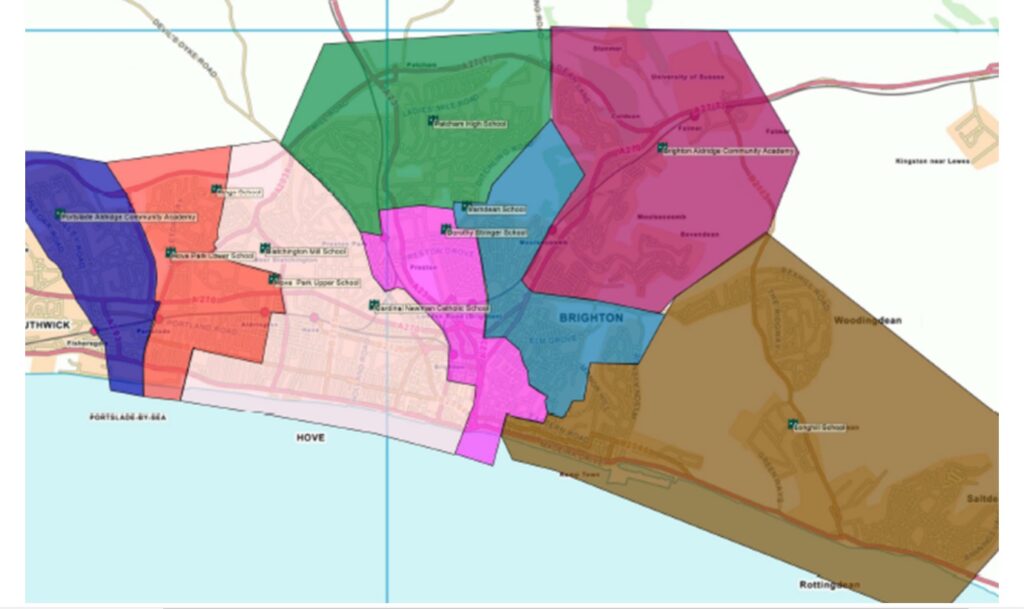
Councillor Taylor, the deputy leader of the council, said: “We want to build an education system in the city that is fair and inclusive – where all pupils can access a great education.
“To do this, we need to address educational inequality in the city, as well as the issue of falling pupil numbers in our secondary schools.
“We’re launching this engagement to identify solutions and ensure the opportunities and outcomes of our children and young people are not dictated by their background.
“We’ve developed three different models that could tackle these issues and ensure all secondary schools in the city are able to thrive. We are keen to hear from parents, carers and the wider community about these options.
“The rules on school admissions mean that we cannot propose a change across all schools in the city, but we hope to work with academy and church schools to do what is right for Brighton and Hove’s children and young people.”
To take part in the online consultation, click here.
The council said: “The survey is open until Wednesday 23 October. We’re also holding three public meetings.
- 6.30pm on Tuesday 8 October at Hove Town Hall
- 6pm on Thursday 10 October online
- 6.30pm on Wednesday 16 October online
“The events are open to everyone. To help us manage the capacity of the Hove Town Hall meeting, we’re asking anyone who would like to attend to book their place through Eventbrite.
“Following this, the cabinet will decide whether to carry out a formal consultation on making a change to secondary school admission arrangements in November.
“Any changes agreed to school admissions in the city would take effect from September 2026.”

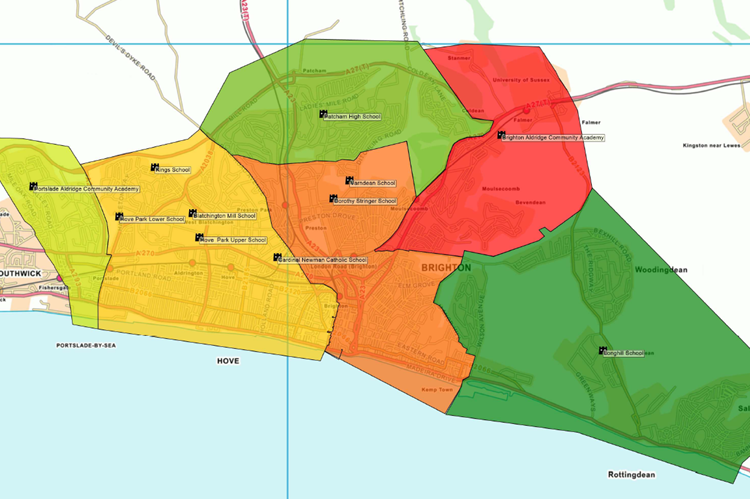









Just shows what 14 years of austerity causes: more disadvantaged children on free school meals. Allied to rising rents caused by property speculators & Air B&B rentals: displaced families leading to falling school places. Good luck for the future.
It all links together, doesn’t it Ann?
Some gentle pressure on religious schools to accept more fsm students as they are obviously cherry picking… Are we totally sure that the school age population won’t rise at some point in the future? Most stats point to a general UK population rise esp with global warming? what is happening to the proposed housing estate to be built on Toad’s hall lane? could we make Brighton a little more kid friendly so families will stay? Perhaps focus on early years and get all the nurseries together for a forum to discuss subsidies, pricing, staff training opportunities/integrated services. Better Splash parks with actual water, invest in the swimming pools, interesting playgrounds with tunnels, longer slides, sand pits and zip wires. Cleaner toilets etc.. integrated school buses so they can move across town to different schools – perhaps include 16-18yr olds in this. Introduce universal primary school fsm? Education maintenance allowance to encourage attendance? An air bnb tax? Such a shame that we will be recruiting fewer teachers in future despite our schools performing so well compared to other regions with rubbish academy chains that can’t recruit at all.. and one of the best teacher training depts in the uk … if Brighton turns into a millionaire’s playground there won’t be anyone in the service sector left to serve them…
I think the numbers you are quoting are for one years intake across all schools, not the total number of pupils in all secondary schools?
Thanks Sean. I’ve gone back through the story and hopefully it’s as clear as it can be now.
Time for our red Tory government to force academies and free schools to be part of LEA admissions policy. Many of these schools cherry pick their pupils (Kings School and Cardinal Newman have very low numbers of kids on fsms for example).
The problem: chronic underfunding of schools. Low demand for schools which are struggling. Lack of resources to attract & retain teachers.
The proposed solution: spread the meagre resources more thinly. Restrict the number of places at the popular schools, so even fewer people get the local school & those schools have fewer resources. Ensure that hundreds of parents & children from all over the city have to travel 5,10,15 miles a day, to schools they don’t want to go to.
A parent did what the council should have…
https://adamdennett.github.io/BH_Secondary_Admissions_Analysis/BH_Sec_Sch_Analysis.html
The information is very misleading.
Disadvantaged children (those on Free School Meals) are already higher on the priority than catchment area applications and so effectively can go to any Council Maintained school in Brighton. Changing the boundaries makes no difference to this giving those on Free Meals any greater access.
I note from link below that Councillor Taylor has 2 young children and lives in Brighton – it would be interesting how these changes would impact his children’s choices? Given the changes are not relevant to disadvantaged children but appear to have another driver!
https://lga.moderngov.co.uk/mgUserInfo.aspx?UID=4899
I’m still trying to put my head around it, but are they saying the solution to this problem is to take pupils from good-performing schools that they are local to and make them travel for miles to a school that is performing worse? How is that solving anything?
All children deserve access to good attainment outcomes to be able to go on to apply for whatever 16+ education they want. Only way to ensure equality in the city is to break generational educational ‘ghettos’ and mix up schools. For a ‘liberal’ city like Brighton I’ve heard a lot of class snobbery.